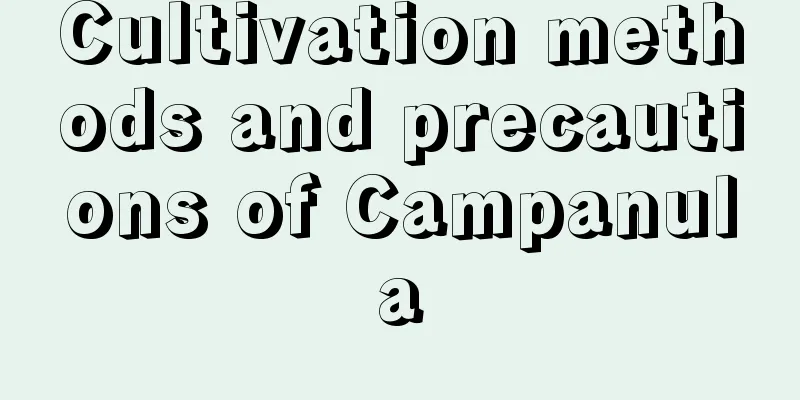Cultivation methods and precautions of Campanula

1. Maintenance methods1. Temperature: The temperature suitable for plant development is between 15 and 25 degrees. The temperature for wintering must be kept above ten degrees. Therefore, it is best to move plants planted in the north indoors for maintenance in winter. 2. Watering: The plant consumes a lot of water during the growing period, so the soil needs to be kept moist for a long time. Generally, water the plant once every two days. When it is not growing, water the plant appropriately, usually two to three times a week. When the temperature drops below minus ten degrees Celsius, cut off watering to avoid the water temperature being too low and aggravating the frostbite of the plants. 3. Fertilization: It likes fertilizer. When it blooms, the flowers bloom continuously, and the demand for nutrients is even greater. The nutrients in the soil alone are far from enough. Artificial fertilization is needed to meet its needs. Generally, during the growth period, it needs to be fertilized once every half a month. When fertilizing, use mainly compound fertilizers with mild fertilizer effects and easy absorption. You can also use homemade compost. Compost is made like this: put rotten fruit and vegetable peels and animal offal together, then bury them in the soil and let them ferment fully. After fermentation is complete, it becomes compost and can be used directly for plants. 4. Light: It is not resistant to strong light. Excessive light will cause the branches and leaves of the plant to curl and die, so it needs shading, especially in summer. It can be exposed to normal light in the morning and evening, but needs shading at noon. It is sufficient to ensure six hours of light a day. 2. Breeding techniques1. Reproduction: It can be propagated by sowing. The broadcasting method is used for breeding. Under temperature conditions of 15 to 25 degrees, the seeds will germinate in half a month. When it grows two true leaves, it is time to transplant it. 2. Pruning: The general method of pruning plants is to pinch the top. Pinching can promote the growth of lateral buds, avoid apical dominance, and make the nutrient distribution more even. After pinching, the incision should not come into contact with water for the time being. After the incision is dry, you can water it normally. 3. Problem Diagnosis1. Yellowing of branches and leaves: The yellowing of branches and leaves of campanula is mostly caused by excessive light. It is necessary to properly control the light and ensure that the plant will not be exposed to strong light. When irradiating, mainly diffuse light should be used, and this problem will be solved. 2. Root rot: Root rot may be caused by excessive watering, which leads to water accumulation in the pot soil and the soil is not breathable. You need to dig it out of the soil, cut off the rotten roots, and then replant it in soil with good air permeability. IV. Other issues1. Toxicity: non-toxic. 2. Edibility: It cannot be eaten directly, but it can be used as medicine. |
<<: Hypericum cultivation methods and precautions
>>: Bitter melon cultivation methods and precautions
Recommend
Prevention and control methods of asparagus fern blight and yellowing disease
Branch blight of Asparagus fern Dieback disease s...
Euphorbia gejin sowing method
1. Is sowing feasible? Euphorbia gejin is a varia...
How to grow large orchids and precautions
Growth habits of large orchids Large orchids pref...
Appreciation of Chlorophytum
effect According to research, spider plants have ...
Can leftovers be used as fertilizer?
Leftovers as fertilizer Leftover rice can be used...
When is the right time to sow astragalus
Suitable time for sowing Chinese milk vetch Astra...
The efficacy and function of jasmine
The ornamental value of jasmine Forsythia usually...
The meaning of Areca palm
1. Four-sided Tengda The plant of Areca palm is t...
How to propagate Osmanthus fragrans and what to pay attention to
Reproduction method of Murraya paniculata There a...
How long can potted lilies live?
1. How long do you live? It is a perennial herb. ...
How to grow Chrysanthemi orchid
1. Soil It usually grows better in soil containin...
How to water bamboo cypress
Habits of Bamboo Cypress This plant likes to grow...
When is the best time to plant lettuce?
In recent years, romaine lettuce has been loved b...
How to trim Ophiopogon japonicus
When is the right time to mow Ophiopogon japonicu...
Cultivation methods and precautions of lotus orchid
Lotus orchid is not very difficult to grow. The p...









